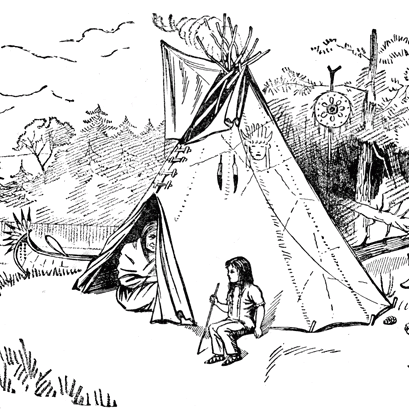
FAMILY LIFE, THE CHILDREN, DUTIES
|
A child is a special gift from the Creator.
Each child is born with gifts. A loving and caring home will bring out these special gifts in the child.
Caring for children is a sacred and shared responsibility.
Parents and families are the first teachers and caregivers of their children.
|

Babies were wrapped in a moss bag and tied to a cradle board. A moss bag was made of hide and filled with dry moss or cattail down. Sometimes buffalo chips were added. The soiled moss was emptied and replaced when needed.
Some cradle boards were U-shaped frames. The curved part at the head of the board kept the baby's head from falling forward. Some cradle boards were flat boards with hide attached for holding the baby. The mother would tie the cradle board to her back and go about her work, or she could lean the board against something.
photo of cradle boards

Children were taught through stories and legends told by their elders. Grandparents were in charge of taking care of the children while their parents were busy with daily tasks. Children were taught how to become helpful members of the tribe.
Little girls played with toy tipis and deerskin dolls. Little boys had small bows and arrows and pretended to go on hunts and raids.
more about TOYS AND GAMES
As they got older, the boys learned to hunt and fish. They were taught how to carve hunting and fishing tools from bone and wood. Wrestling games were a part of their training to prepare for battle.Children were taught to ride horses at an early age. Boys were trained to use a bow and arrow on the horse so they could become skilful hunters. When the boys reached the age of 12 they went on their first real hunt.
They also learned about ceremonies.
A young man went on a vision quest to become strong. He would leave the village and not eat for days. He remained in a lonely quiet place until he had a vision or a dream. It was believed that the vision quest made boys into strong fighters and good hunters.
Upon reaching adulthood the young men received an eagle feather. The eagle feather was given for performing an act of bravery or a heroic deed. Eagle feathers were often worn in headdresses.
Young girls were taught to sew and decorate moccasins and other clothing. They learned which plants to collect for food, how to snare small animals and how to cook. They were taught how to tan hides and to make birchbark containers.
- took care of the tipi (setting up and taking down)
- raised the children
- packed when it was time to move
- helped butcher the animals
- gathered berries and other plants
- collected firewood
- prepared the food
- prepared the skins (cleaning, curing, scraping and tanning)
- made clothing and other articles
- quilling and beadwork
- taught the girls the same duties
THE MEN - duties
- hunting
- protection
- fought in battles
- taught the boys to hunt and fight
- made tools, weapons and shields
WINTER CAMP
The Plains tribes lived in small groups or bands during the long winter months. For five months of the year (November to March) they lived in one place - known as the winter camp. The winter camp was set up in a protected area where there was water, wood, game and grass for the horses.
Then in late spring or early summer, the bands would get together again for religious ceremonies, important meetings and the yearly bison hunt which took place in late summer and fall.
Each band was headed by a council and a chief.
Royal Saskatchewan Museum display - winter camp | the tipi
| index | introduction | words | beliefs | food | clothing | tipi | bison |
| decoration | family & daily life | tools | transportation | links |
photo - cradle boards (Indian Museum of North America
Crazy Horse Memorial, Black Hills, South Dakota)
credits for graphics and information
J.Giannetta, 2002
(updated April 2012)
Web Pages for Students